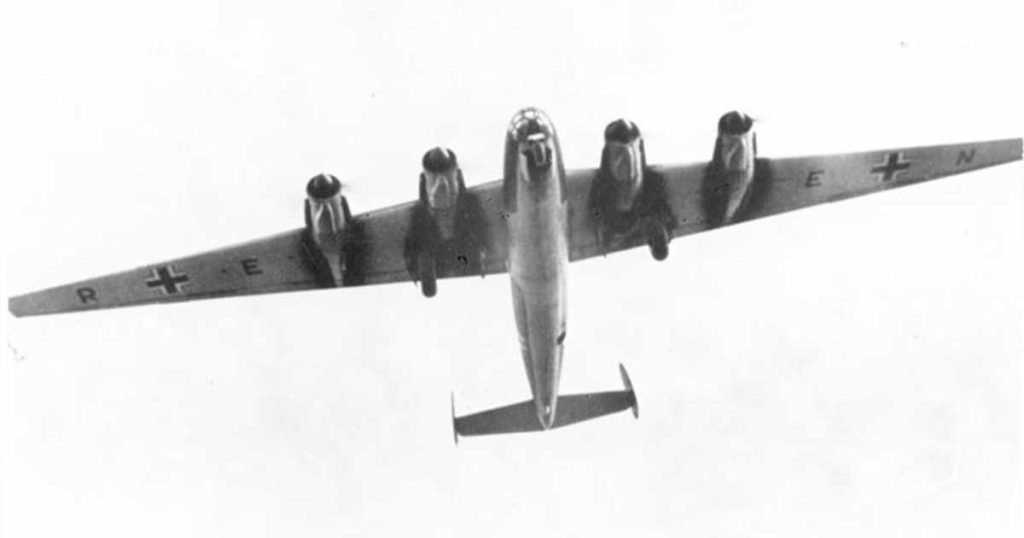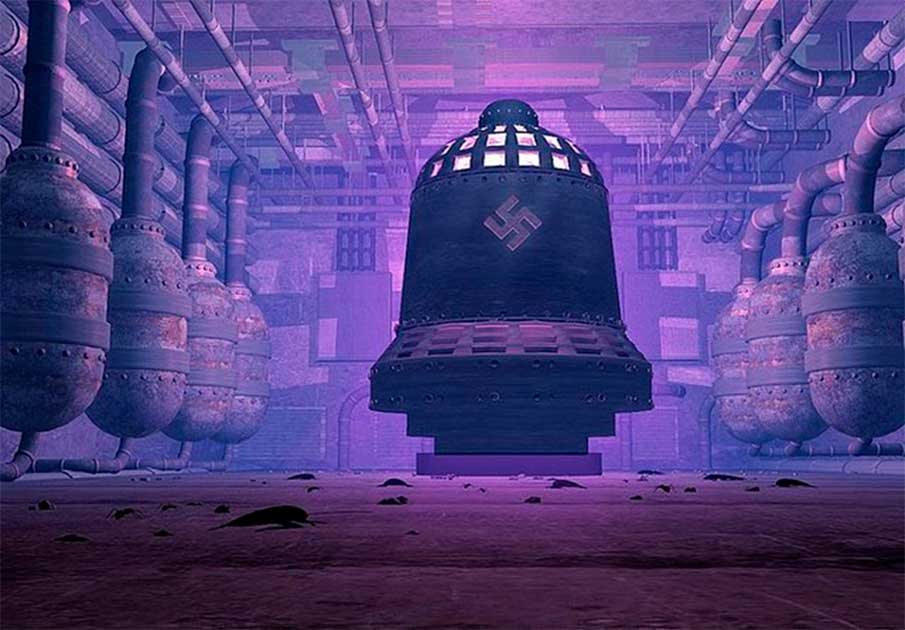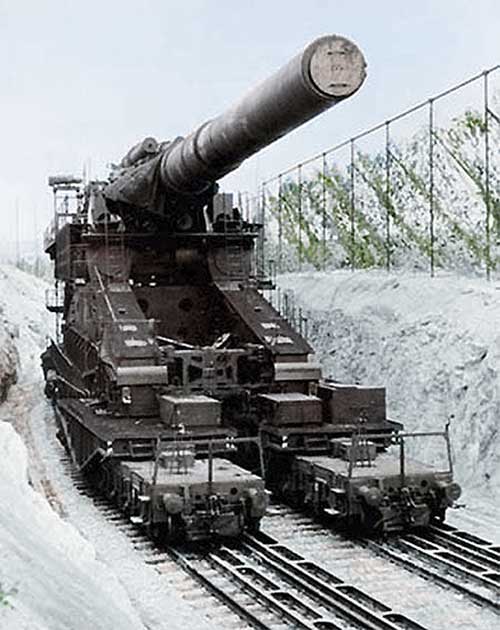By 1942, with the tide of the Second World War turning against Nazi Germany, Hitler in his desperation put his faith in “Wunderwaffen”: so-called “miracle weapons” which, he hoped, could win him the war. These inventions were often outlandish and impractical, but it seems that where innovation was concerned nothing was off the table.
From huge tanks and super long range bombers to rocket-powered planes and giant guns, these weapons were strange and unique. And it was the Fuhrer’s hope that, just maybe, they might turn the tide.
1. Amerikabomber
Not so much a single concept as a design brief, the purpose of the Amerikabomber was simple. Hitler intended to field a military plane capable of reaching the continental United States.
America had long been protected by the distance from its rivals in the two world wars, and this led to a confidence in the American public which was bolstered by two decades of isolationism and the belief that they could not be touched. If American cities could be reached and targeted, it was hoped that public sentiment would turn against the war in distant Europe as US civilian casualties mounted.

This was the same logic which led to the Doolittle raid, where US bombers flew sorties against Japan from extreme range, and it was hoped the impact on US morale would be crushing. In the event, none of the planes designed was feasible to make the long journey across the Atlantic.
In a twist of fate, it would be the Germans who felt the blow to morale when, instead of German bombers over US cities, American P51 fighters reached Berlin. Reichsmarschall Goering, when he saw the allied fighter aircraft, is reported to have said that he knew then the war was over.
2. Kugelpanzer
At the other end of the scale we have the Kugelpanzer. A small, spherical, one man tank, this bizarre contraption is known from a single example recovered by the Allies at the end of the war.
It seems to have filled an infantry support role of sorts. Barely bigger than a modern compact car and with room inside for only one man operating the controls and the forward mounted machine gun, it would handle rough terrain and could shelter infantry as they advanced.
But the truth is we just don’t know. In the chaos at the end of the war many documents and records were simply lost. We can only guess at what it was the Nazis were trying here, but it would seem that with only a single example built, it did not work.
3. V2 rocket
Unlike the Amerikabomber and the Kugelpanzer, the V2 rocket was proof that blue-sky thinking and innovation can result in effective and dangerous weaponry. A replacement for the V1 “doodlebug” flying bomb (the “V” stands for “vengeance”), the V2 utilized advanced Nazi rocket technology to launch devastation on London and the south of England.
By the time of the introduction of the V2, Allied fighter pilots could reliably intercept the V1 and its usefulness was limited. Slower that the updated versions of the Supermarine Spitfire Allied fighter aircraft, the V1 could be knocked out of the sky with relative ease.
But the V2 could not be stopped. Flying at supersonic speeds and with a far larger explosive payload than the V1, the V2 bought a whole new phase of the Blitz to the United Kingdom. Thankfully they were extremely expensive to build and launch and as a result were used in limited numbers.
4. V3 Cannon
The successor to the V2 rocket took things in a wholly new direction. Nazi scientists reasoned that a gigantic cannon, built in an underground bunker hidden in the woodland of northern France, could target London and demolish the capital with a steady stream of high explosive projectiles.

This V3 cannon would have significant advantages over the V2 rocket, with which it would operate in tandem. A shell from the V3 could cause the same damage as a V2 at a significant cost savings, and in theory with a far greater rate of fire. As with the V2, nothing could be done to stop the shells and it was hoped the devastation caused would bring Britain to her knees, and Churchill to the negotiating table.
The complexity of the gun and its appearance too late in the war meant that this never happened. The Allies got wind of the hidden bunker and the Nazi plans, and on 6th July 1944 Allied bombers demolished the site.
5. The Komet
Nobody doubts the bravery of fighter pilots, but it was a brave man indeed who would take to the skies in a Komet. A tiny fighter plane shaped like a flying wing, this little aircraft could travel at extraordinary speeds as it intercepted Allied bombing raids.
This wasn’t a jet however, but a rocket, relying on igniting its onboard propellant directly rather than mixing it with air drawn from intakes. This propellant was highly concentrated hydrogen peroxide, foul stuff and extremely unstable, with more than a few pilots and ground crews dying from airfield accidents.
All this for seven minutes in the air, but in that time the Komet could reach 550 mph (880 km/h), far faster than any Allied aircraft. This actually became a problem as Komets struggled to engage the bombers: they only had a few seconds before they overshot their target. Further innovations such as light-activated upwards facing cannon (triggered automatically when the plane flew under the wing of a bomber) did not solve the problem, and the Komet was only of limited effectiveness.
6. Die Glocke
As with the Kugelpanzer, Die Glocke (“the Bell”) is shrouded in mystery. Surviving only in rumors and speculation, we do not even know what it was for, exactly, and it is almost certainly a hoax started far later.
The stories attached to Die Glocke are almost unbelievable. It was huge, it utilized sonic weaponry, it could levitate, it could manipulate time. While there are certainly useful military applications for floating time-travelling contraptions, the truth is we do not know what it looked like, what it is, how it worked and what became of it.

Rather prosaically, the most likely explanation is that this is a later fiction. No record of Die Glocke exists before the year 2000, when a Polish journalist named Igor Witkowski first mentions it in a book. It seems this this invention is more fantasy than reality, drawn from post-war paranoia and given new life in the modern age as a conspiracy theory and a fantasy.
7. The Landkreuzer Ratte
The heaviest and largest tank ever built in history was made by the Nazis. Named the Maus (“mouse”), it was essentially an enormous mobile artillery platform with a fixed forward facing cannon. But the Maus was nothing compared to the Ratte.
The Ratte was a proposal for a 1,000 tonne (1,100 ton) superheavy tank. Bristling with guns and almost indestructible, this absolutely enormous vehicle would be able to destroy anything on th battlefield with impunity.
Of course such an idea was also hugely impractical: bigger is not always better. The Ratte was too large and too heavy to function effectively using existing roads and infrastructure, and lessons learned from the slow, unreliable and enormous Maus meant that the slower, larger Ratte never saw the light of day.
8. The Mammut
It does seem that the Nazis did like to build them big, however. The flying equivalent of the Ratte was the Junkers Ju 322 Mammut (“mammoth”), an enormous glider large enough to carry a tank.
Unlike the Ratte however, the Mammut was actually built. Two examples were completed and, once airborne, it proved a stable and potentially viable transport aircraft. Built largely of wood, it would have been cheap to construct and in large numbers could have given the Nazis unparalleled strategic mobility.
Sadly, Nazi high command did not see it that way and felt they did not need another large transport glider. The Mammut was scrapped in 1941. Perhaps the fact that it took engineers two weeks to recover the prototype to the test airfield after the inaugural flight had something to do with it.
9. Schwerer Gustav
The V3 cannon was not the only giant gun the Nazis built in the Second World War (perhaps Hitler was compensating for something). The Schwerer Gustav, unlike the V3, was up and running at the start of the war and, unlike the V3, could move.

Mounted on a train, the Gustav built on technology first deployed in the First world War with the “Paris gun”. It was designed to destroy the French fortifications on the German frontier known as the Maginot Line.
In the event, it was not ready and not needed. The Nazis found that it was a lot simpler to go around the Maginot Line through Belgium, and France fell without Gustav firing a single shot. It saw action on the eastern front against Russia, before being destroyed by the Nazis in 1945 to avoid ti falling into enemy hands.
10. The Sonnengewehr
This one comes straight out of a James Bond novel. The Sonnengewehr, or “Sun Gun” was essentially an early orbital weapon, a giant mirror which would annihilate its target with concentrated solar rays.
By the start of the Second World War this idea had already been around for a decade. German physicist Hermann Oberth had first proposed the concept in 1929, and it was revived by Nazi scientists and proposed as an untouchable weapon of absolute destruction.
The science does indeed check out, but the timescales sadly did not. When asked how soon it could be in operation, one scientist estimated that they could have it up and running in 50 to 100 years. Not the silver bullet Hitler needed, and thankfully the project went no further.
Top Image: Hitler inspects the Schwerer Gustav, an enormous cannon mounted on a train (manhhai / CC BY-NC 2.0)
By Joe Green